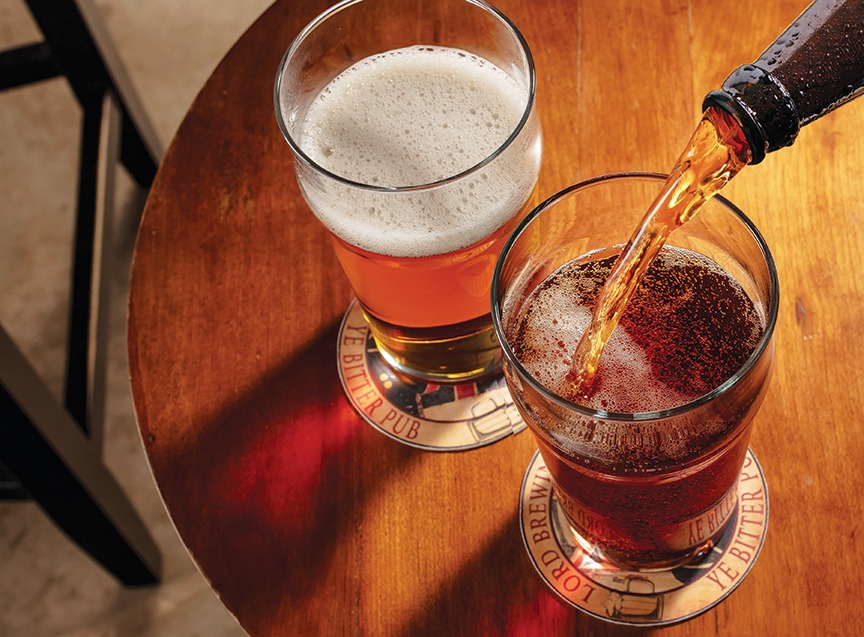Fruit Beer

Frankly, the guy looks pretty serious, pretty stern. It’s easy to imagine him supervising every step of the operation, judging the quality of the hops, the malt, the maize—probably a tough man to work for and a hard taskmaster. In all likelihood, he was thoroughly steeped in German brewing traditions; his common technical language with other brewers was German, not English, and his notion of beer was German, with some American pragmatism thrown in. It’s a great photograph; I don’t have any trouble imagining any of this.
What I can’t for the life of me imagine is calling this brewmaster into the corporate office and informing him that we’ve decided to add a new beer to the line: Weinhard Marionberry Pilsner. Did he have a sense of humor? Would he chuckle heartily and then go back out to his kettle? Or would he fix me with a fierce Prussian glare and assure me that there was no Marionberry in Pilsner. In fact, there was no fruit in beer. Period.
Fruit doesn’t get much respect, even as wine. Wine snobs—er, connoisseurs—refer to them (the non-grape variety) as “country” wines, and one rarely finds these poor sisters, with their clodhoppers and matted hair, at the table with the cabernets and chardonnays. And if fermented fruit doesn’t get any respect in wine, where it technically belongs, how are we to view it in beer? Beers are made from malted grains, barley, or sometimes wheat, but fruit?
While it’s possible that fruits were occasionally added to beer in its early history (along with all manner of herbs and spices), the only surviving fruit beers are found—unsurprisingly—in Belgium. Most commonly, these are made from a lambic base; a unique style of spontaneously fermented beers in which an array of yeasts and bacteria—and the combination of barley and wheat—provide a riot of flavors. The best of these combine the tartness of the beer with the sourness of the fruit in a lively, effervescent brew that has more in common with champagne than with pilsner.
In most of these beers, whole, macerated fruit is added after the initial fermentation is complete, and a second fermentation of the fruit sugars begins. Frequently, the beer is then blended once again, with an un-fruited lambic. Very dark, intense cherries (for kriekbier) and raspberries (for framboise) bursting with flavor were the prevalent choice for years, but recent interest in lambics has caused some experimentation and the introduction of new variants, such as peche (peach) and cassis (currant). In the pursuit of a faster brewing process, some breweries have turned to concentrates, syrups, or essences in lieu of whole fruit.
Whole cherries and raspberries are likewise added to a remarkable tart brown ale at the Liefman’s Brewery in a different region of Belgium. Unlike the pale lambics, Liefman’s beer has a tremendous color and depth of its own. When combined with the intense dark cherries, Liefman’s Kriekbier goes down like Black Forest cake when first bottled. Over time the beer dries out and the sour/tart flavor comes to the fore.
Even the staunch Purity Law Germans are not above taking some liberties with fruit, although “fruit beers” as such are verboten. At Munster’s Pinkus Muller brewpub, the dry, crisp altbier (made, like the lambics, with a large portion of wheat) is served with seasonal fruit. The fruit is macerated and then soaked in syrup; the beer is added to the glass and the Pinkus Alt is poured over.
Here in the US fruit beers are exploding on the microbrewery scene. In the mid-’80s, as Portland, Oregon’s brewery scene was gathering momentum, the McMenamin brothers gave their first brewpub a novel cast by adding odd ingredients to the beer: chocolate and fruit. Fruit? The Bureau of Alcohol, Tobacco and Firearms, which has to approve everything about alcoholic beverages, was not amused. No, fruit went into wine. Grains went into beer. They took a lot of convincing, and for a time each new addition was viewed with suspicion and hostility.
Some of the most interesting fruit beers I’ve tasted are very dry and snappy.
Today fruit beers are everywhere, at least here in the Pacific Northwest. Like their Belgian counterparts, American fruit beers tend to be constructed from a wheat beer base, but the American versions, with much less wheat, are generally blander. In general American brewers get their beer’s pep from hops, and hops make a very poor companion to fruit. While the Belgian versions gain complexity from odd fermentations, most American brewers have stuck with simple, clean ale yeasts.
American brewers tend to ignore another Belgian concept, the use of very tart, acidic fruit. Fruit extracts and syrups, because of their simplicity of use, have found the greatest favor, and their contributions are mostly those of sweetness, some fruity flavor, and fruit aroma. Raspberries, perhaps the most aromatic of fruits, gained an early foothold. Of late, apricot seems to be gaining ground. The Boston Beer Co., badly misusing the term “lambic” for its Samuel Adams beer, did stick to some classic precepts: a wheat beer base and a very tart fruit, cranberry.
In the early microbrewing years, Washington State’s Thomas Kemper Brewery produced something they called a “helles,” ostensibly a pale lager beer. Their original yeast choice, however, had been an odd one and the beer was far fruitier than a lager should be. Curiously, the beer tasted of blueberries, although none were added, and the “helles” gained something of a cult following as the “blueberry beer.” After a new brewer was installed and the brewery started producing true lagers, the blueberry flavor was lost, to some fans’ dismay. Recently, the brewery added art to life by reintroducing their blueberry helles, this time with real blueberries!
Tips for Homebrewers
Generally, American brewers have taken to the convenience of fruit extracts and essences. Few breweries can tie up fermentation vessels for extra weeks on crushed fruit—and fewer still would be enthusiastic about the accompanying mess. For the homebrewer the possibilities are endless. Fruit beers are among the cases in which there simply are no rules. They can be brewed from any base, using virtually any technology. Good fruit can be picked in season, found frozen or in syrups or extracts.
Fruits and fruit syrups can be added in the kettle, but care should be taken not to boil them, so as to avoid pectin haze. If care has been taken to choose undamaged, clean fruit, sanitation should be of limited concern even when the fruit is to be added for a secondary fermentation. Bear in mind that adding a lot of fruit will also add a lot of alcohol to the beer, and be prepared for a vigorous and messy fermentation when the fruit sugars kick in. Give yourself a lot of room in an open fermenter; enclosing the fruit in a mesh bag or a clean stocking can save a lot of trouble cleaning up.
Fruit and hops do not mix. Whatever the base beer, it’s best to keep the hopping rate very low, both in the bittering and the flavor additions. A very late, very flowery hop addition might marry with the fruit’s aroma but is more likely to mask the delicate nose.
Use your yeast. Really interesting fruit beers have something working in combination with the sweetness of the fruit. Some yeast strains that might have produced overpowering esters for a lager or a simple ale will actually enhance the character of a fruit beer.
Carbonation levels should be elevated. A good pale ale is fairly quiet, not too gassy, but a really aggressive level of carbonation can help push the aromatic notes up the scale.
Generally, crisp is good. Some of the most interesting fruit beers I’ve tasted are very dry and snappy. High carbonation helps, as does a very attenuative yeast (one that ferments out virtually all of the available sugars). Generally, too, pale beers work best as showcases for fruit. They allow more fruit flavor to appear, as well as permit the delicate hues of raspberry or cherry (or blueberry!?) to shine.
And yet I’ve tasted some terrific beers that violate that rule. Blackberries grow in profusion along country roads here in Oregon, and every year the state fair homebrewing competition has a huge selection of blackberry porters and stouts. Somehow, the acidity of the black malt works well with the rich sweetness of the berries. Like I said, there are no rules in fruit beers.
Quantities of fruit to be added vary widely. Generally speaking, the heavier the beer, the more fruit is necessary, but the type of fruit makes a tremendous difference.
Raspberries are remarkably aromatic, and it doesn’t take a lot of raspberries to make an impact (and a good thing, too, given how much they cost!). Peaches, on the other hand, don’t have a big punch, like most of the stone fruit. If you can find really intense, dark, tart cherries, by all means use them, but the usual table fruit will need some help.
Perhaps the simplest technique, and an excellent starting point, is to use a fruit extract. Retailers like California’s HopTech carry concentrated fruit flavors in small containers. The great thing about these is that they can be added directly to finished beer during bottling. Not only does it simplify production, but the brewer can experiment with small quantities of beer and small quantities of fruit flavor until a suitable addition for the entire batch can be determined.



